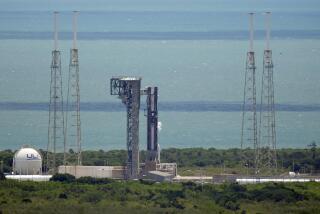Atlantis to try again today
- Share via
CAPE CANAVERAL, FLA. — With erratic fuel gauges still a threat, NASA aimed for a launch today of space shuttle Atlantis after senior managers signed off on a plan to tighten flight rules and shoot for a one-minute window.
Managers say the precautions will keep Atlantis and its crew of seven as safe as possible if, indeed, the shuttle lifts off with a European lab intended for the International Space Station.
On Saturday, two NASA engineering departments recommended delaying the launch and doing additional tests to figure out why so many fuel gauges acted up during Thursday’s launch attempt.
But in the end, they did not oppose trying for a liftoff, said LeRoy Cain, chairman of the mission management team. “We’ll fill up the tank and we’ll see what we get,” Cain said. “If we meet our criteria, we’ll go fly, and if we don’t, we’ll scrub and we’ll get a good tanking test and we’ll go forward from there.”
Under the new rules, NASA will proceed with the countdown only if all four gauges in Atlantis’ big hydrogen tank are working properly. Two of them failed when the shuttle’s tank was filled for liftoff Thursday, and a third one subsequently acted up.
NASA passed up launch tries Friday and Saturday because of the problem, which has plagued the shuttle program off and on for more than two years. After meeting again Saturday, shuttle managers decided to press ahead with a liftoff this afternoon, but only if all the fuel gauges behave.
The gauges are engine cutoff sensors, part of a critical backup system for preventing the shuttle’s main engines from running too long during the climb to orbit. If the engines kept running and the fuel tank was empty because of a leak or other unexpected trouble, they could ignite or explode.
Last year, after struggling in vain with the problem, NASA loosened its launch rules to require that only three of the four gauges be working before liftoff. Managers went back to the four-of-four rule Saturday -- for this mission only -- after concluding that Atlantis’ system was suspect and that it would be too risky to attempt a launch without every gauge functioning.
NASA shortened the five-minute launch window to one minute to put Atlantis on a more direct path to the space station and keep more fuel in the tank, just in case of sensor trouble. And new instrumentation for monitoring the condition of the fuel gauges will be used during flight, enabling flight controllers and the astronauts to intercede in case of multiple failures. The plan was put forth by the astronauts themselves.
Cain said the rules put an added burden on the commander, Stephen N. Frick, and his crew, as well as on Mission Control. He said Frick was “deeply involved” in all of the decisions.
Packed aboard Atlantis is the European Space Agency’s $2-billion science laboratory, Columbus. Japan’s lab Kibo, or Hope, will follow on successive shuttle flights next year.
The Columbus lab has been waiting to fly for years. It was stalled first by NASA space station design problems; then by Russian space station holdups; then by the 2003 Columbia disaster, which grounded all shuttle flights for 2 1/2 years.
NASA is up against a tight deadline for launching Atlantis. If the shuttle isn’t flying by Thursday or Friday, the mission will have to wait until January because of unfavorable sun angles and computer concerns.
More to Read
Sign up for Essential California
The most important California stories and recommendations in your inbox every morning.
You may occasionally receive promotional content from the Los Angeles Times.













